Contractor Stories
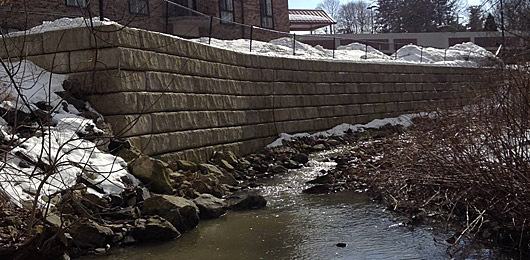
John says they use big blocks mostly for water applications because they hold their place. The danger with a water application occurs when the mass of soil behind the wall is saturated beyond a certain height. "Then if the water level drops too quickly, it will actually suck the wall right into the water. Joe has seen it traveling around the country solving problems for people."
To prevent this they back fill with clean stone for the full depth of the geogrid for each row up to the engineer's estimate for the 100-year flood mark. The stone holds the geogrid and wall in place and allows the water to free-flow in and out.
To prevent this they back fill with clean stone for the full depth of the geogrid for each row up to the engineer's estimate for the 100-year flood mark. The stone holds the geogrid and wall in place and allows the water to free-flow in and out.
Lessons learned from years building walls
Continually expanding skills and improving efficiencies ensures success in the constantly changing market.
By Tom HatlenIn 1986 John Franklin was general manager for a large landscaping company when he heard about a new product, a "Keystone wall."
"We were building retaining walls out of boulders and other natural stone. We could put up a Keystone wall in 1/10 of the time. It was amazing, and it was in demand. It's what I love to do, running heavy equipment and moving earth. I worked on a farm as a kid, and once you smell dirt and diesel fuel plowing a field, it gets in your blood. There's nothing like it."
He steered the company to become retaining wall specialists. His expertise grew to the point where he was hired to help grow a retaining wall division for a huge regional construction company. That's where he met Joe Powers who would become his boss.
The John and Joe story
Joe had also been running a large landscaping company when SRWs came on the market. And, like John, he embraced their potential. Together, they built a multi-million dollar division. John says, "Joe's function was to get all the work. My function was to make it all happen."After a 10-year run, both left the company. John started his own business in 2004 after 18 years of working for other people. Joe was traveling the world as a construction consultant for Anchor Retaining Wall until family health issues brought him home. He could have easily retired, but the 2 had kept in touch, and about 3 years ago he went to work for John doing sales and estimating.
John looks to Joe as his mentor. Joe says they get along just fine with the roles reversed. "He's a great boss. I know what it's like to be the owner. We discuss things, but I respect that he's going to do what he's going to do. He's a smart guy and I trust him."
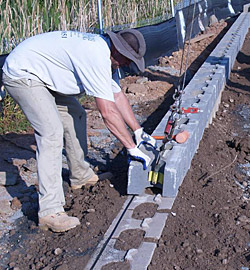 | 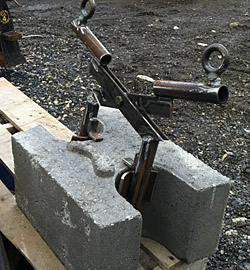 |
John and Joe invented a Block Picker attachment for installing standard SRW blocks with an excavator. John says, "It picks up the block and puts it on the wall. I have 3 guys and a mini-excavator putting more block on the wall than when I had 5 guys out there. We get 8 blocks a minute on the wall. It's 1 guy on the pallet, 1 guy on the machine, and 1 guy on the wall."
Staying ahead of the game
They've seen massive changes in markets over the years. Joe says margins for general commercial SRW installation are much tighter now than they were in the earlier years, especially since 2008's great recession. And, adding on travel costs to take on regional jobs would boost pricing out of contention.They both are very much on the same page as to the direction of the industry and the direction of the company. Today's competitive environment reaffirms the need to stay ahead of the game. John says, "We stay on the leading edge of what's happening. We roll with whatever's going on, and do what it takes to learn new and better ways of doing things."
PROFILE
Franklin Construction
Springhouse, PAFounded 2003
John Franklin, Owner
Joe Powers, General Manager of Estimating & Sales
Customer base
10% residential90% commercial
Services
70% MSE structures15% pavers
10% site contracting services
5% landscaping/lighting
Largest project
$900,000Annual sales
2012 - $1.8 million2013 - $2 million
Employees
16 - 24John says, "We focus on more technical work. We have a lot of tools in our bag for value-engineering and offering the best solution to solve problems for the site guys. Profits are higher there.
"With the knowledge we've gained we have the ability on most projects to influence specifications, to help people understand the best way to do things. And it's a homerun because it can save them a lot of money."
Searching for efficiencies
Staying competitive also requires a continual search for new, more efficient installation methods and equipment. With so many years working in the field, John has also developed several major improvements on his own.He created the WallPro retaining wall shimming system now being sold by Dimex. He and Joe invented a Block Picker attachment for quickly installing standard SRW blocks with an excavator. And he developed a system to level the first course of a wall in 1/4 of the time and that doesn't involve hitting blocks with hammer. That last system is proprietary.
Many of the major equipment/systems that allow them to be more efficient also reduce wear and tear on employees. With the Block Picker, employees aren't lifting wall block. With John's first-course wall leveling system employees aren't swinging hammers. They also use the Pave-Mor vacuum paver lifting tool so they're not lifting pavers.
John says, "It took years for my body to recover from building walls the way we used to. By using those types of new technologies, the longevity of someone staying in this industry increases dramatically."
Joe adds, "We have respect for the man-power we put in the field, that they're not mules."
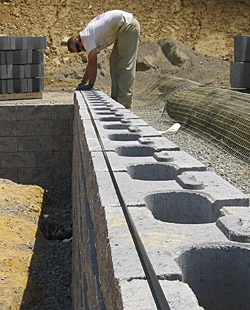 | After 25+ years of shimming retaining wall block, John came up with a solution called WallPro (narrow black strip in photo) now marketed through Dimex, LLC. He says minor block imperfections are no problem for short walls. "But if it's 30 courses high, and the block's off by just 1/16-inch, multiply that course by course by course, and it can point load. All the weight goes on the lowest point of the block and it can send a fracture line down the entire face of the wall." He says point load cracks don't mean a wall will fail. But clients don't like it, and that's a problem. Most contractors use roofing shingles as shims. John says, "It used to drive me crazy. We had somebody sit at the shop periodically and do nothing all day long but cut 1" strips of roofing shingles. It's not cost effective. It's a pain to use, and it breaks apart." So he came up with the idea for WallPro, a quick and easy-to-use block shimming product that holds up over time. |
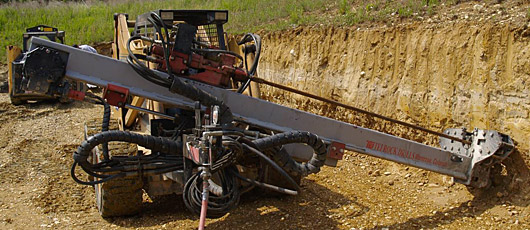
| Knowing how to install earth anchors is one thing, but owning the drilling and load testing equipment to install them takes Franklin Construction to a different level. John says they bought the equipment partly because everyone else rents it. Owning the equipment adds to their credibility as earth anchor experts. "We get phone calls now, 'We heard you guys do earth anchors. We've got a 300-year-old tree. Can you guys drive some cables 20 feet into the ground to keep it from falling?' And the answer is 'yes.' The application is so versatile you can use it for all sorts of different things." | 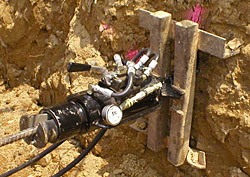 |
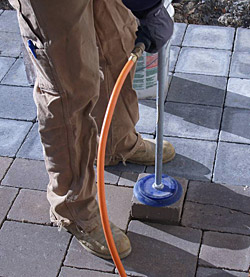
John says they recently invested in Pave-Mor vacuum lifters for installing pavers. "We just did a job about 5,000 sf with standard-sized pavers. We cut our labor time by 30%. We set up a compressor with 150' of hose on each gun and we had 2 guys laying pavers every day, and they just went. It was phenomenal and we'll be using it on every job. We didn't have to bend over or get on our knees."
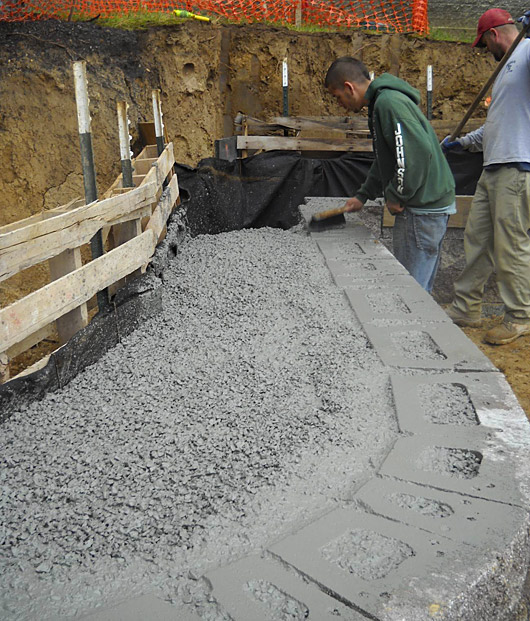
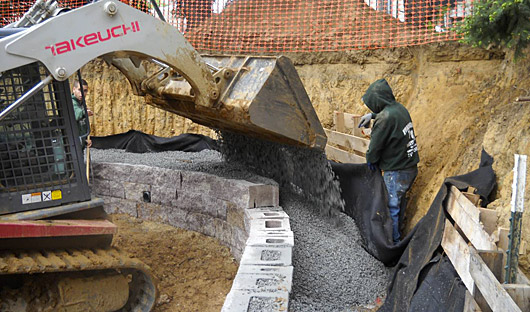
If the site excavator over-digs behind a stabilized aggregate wall, the crew shores up the back of the wall mass to the depth it should have been excavated. Then they fill the back with soil, and don't waste concrete.
Joe was actually part of the team that launched the use of stabilized aggregate in retaining walls to the U.S. John says, "We do a lot of [stabilized aggregate] walls because somebody might need an 8' or 10' high wall up against a cut and they don't have the room for the grid to go in. It's my favorite thing to do. It's so fast and so efficient."
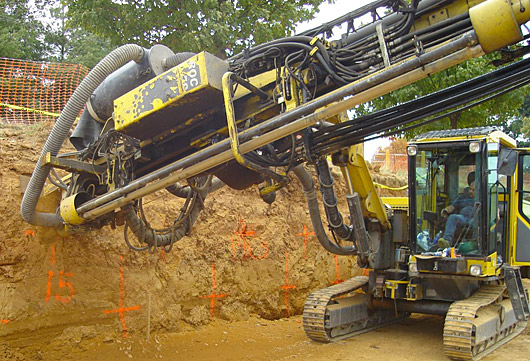
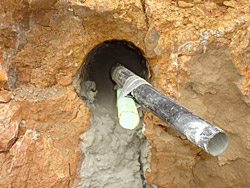 John says soil nails are the strongest stabilization method they use, but they're also the last resort at $1,100 to $2,200 per nail depending on the facing of the cut. They're used for extremely bad soils when there's no room for geogrid. John says they use a track drill to drill a hole into the earth, maybe 20'. "Then you sleeve the hole. You slide the nail in. You pump in gravity grout and it mushrooms out on the bottom."
John says soil nails are the strongest stabilization method they use, but they're also the last resort at $1,100 to $2,200 per nail depending on the facing of the cut. They're used for extremely bad soils when there's no room for geogrid. John says they use a track drill to drill a hole into the earth, maybe 20'. "Then you sleeve the hole. You slide the nail in. You pump in gravity grout and it mushrooms out on the bottom."












